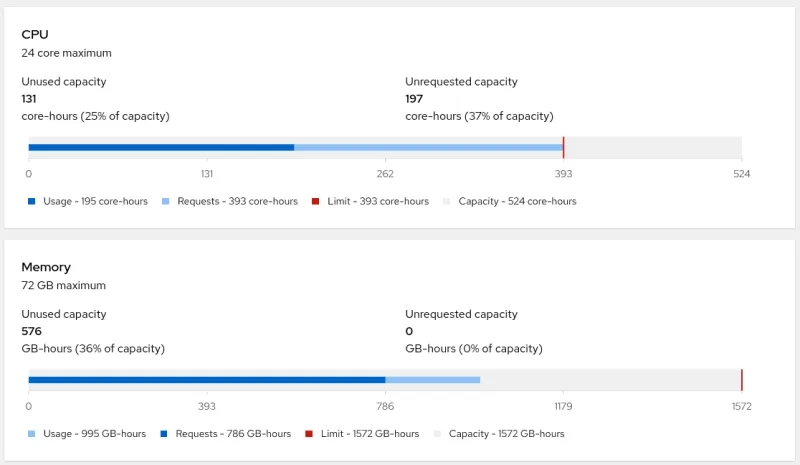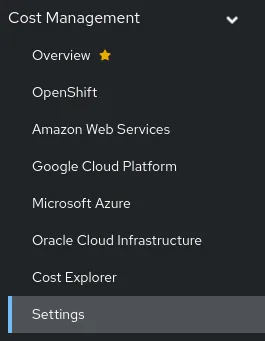It was summer in the Northern Hemisphere, and many people took some time off for vacation, but the Red Hat Insights cost management team kept working hard to make the product better. Let's talk about what's new in our cloud and on-premise cost management tool, which comes at no additional cost since it is included in your Red Hat subscription.
Report vCPU count, RAM and storage capacity
Insights cost management comes with batteries included: When you register your Red Hat OpenShift clusters and connect your cloud accounts (if your clusters run on the cloud), we will automatically distribute your costs according to smart defaults, e.g., cost distribution based on effective CPU usage and, in the default configuration, no distribution of overhead costs.
You can customize this by defining a cloud cost model in the Insights cost management UI and an OpenShift cost model, which will open advanced capabilities such as cost distribution based on requested, used, or effective CPU or RAM usage, distributing the overhead costs of Kubernetes/OpenShift control plane, etc. That's for the costs that the cost management service is aware of.
Typical IT workloads and departments incur additional costs: Subscriptions, external services with variable costs (e.g., using services like Google Maps), outsourcing, cost of the IT employees, etc. Distributing these costs is individual based on your unique needs. One popular way is to redistribute and align them with OpenShift workloads, which requires knowing how many CPU cores and memory the OpenShift nodes and clusters have and have used so those numbers can be extended for other costs.
It is possible to approximate these values by taking the CPU core-hours and RAM GB-hours and dividing them by the number of hours in the month ("CPU_core_hours / #_hours_in_month" or "RAM_GB_hours / #_hours_in_month"), but if autoscalers are used, those numbers would not be right.
In the latest release of Insights cost management, we are reporting the number of CPU cores and RAM. We are also informing you about the maximum value since autoscalers may have changed the capacity at any given time during the billing cycle.

Settings page: Redesigned and moved
For a long time, the Red Hat Insights cost management settings page lived within the Hybrid Cloud Console settings. While this looks correct, it was sometimes hard for users to discover the settings, and therefore, many users were operating with only the default enabled tags (cloud but not OpenShift), currency (USD), etc.
To accommodate cost management users who want cost reports based on tags, use different currencies, or even want to see the AWS costs in a different way than the default (e.g., amortized instead of unblended), we have moved the settings page inside cost management for easier discoverability and enhanced the "Tags and labels" and "Cost categories" subpages. The cost models page has been moved inside the new settings page too.
While moving the settings page inside cost management, we have also relaxed the permissions - only "Cost Price List Administrator" permissions are now needed. In the past, modifying the cost management settings required Hybrid Cloud Console-wide "Organization Administrator" permissions, which made some customers uncomfortable because it gave tag managers too much control and visibility.


Optionally show overhead costs
When running workloads on OpenShift, users are interested in the cost of the workload. They also need to consider the cost of the OpenShift control plane and the cost of the unallocated capacity (also referred to as "overhead costs").
A previous release of Insights cost management enhanced cost models and started reporting those costs. With this new release, we are allowing you to not only distribute the costs, but also dynamically switch to viewing costs with or without overhead cost distribution so you better understand the distribution of your spending.

Large customer data pipeline
Many organizations that use Insights cost management are big customers, but no matter your infrastructure size, we've got you covered.
The latest release of Insights cost management implements separate pipelines for different customer sizes so that cost management processes data from all customers and is responsible, even if some large customers decide to send data for a whole month for a thousand clusters at the same time.
You make Insights cost management better
All of the above features resulted from customer requests for enhancements, which were accepted and prioritized in our backlog. Every bit of functionality described here is available through the web UI and the cost management API (in fact, our UI is built on top of the same API users have access to).
Are you missing something in Insights cost management? Check our backlog in Jira (it's public!) and join our public announcement mailing list. If you can’t find that one feature or enhancement you really need, get in touch with your Red Hat account manager or with Red Hat Support to open a new request for enhancement.
저자 소개
Pau Garcia Quiles joined Red Hat in 2021 as Principal Product Manager. He has 20 years of experience in IT in various roles, both as a vendor and as a customer, systems administrator, software developer and project manager. He has been involved in open source for more than 15 years, most notably as a Debian maintainer, KDE developer and Uyuni developer.
유사한 검색 결과
Solving the scaling challenge: 3 proven strategies for your AI infrastructure
From incident responder to security steward: My journey to understanding Red Hat's open approach to vulnerability management
Technically Speaking | Platform engineering for AI agents
Technically Speaking | Driving healthcare discoveries with AI
채널별 검색
오토메이션
기술, 팀, 인프라를 위한 IT 자동화 최신 동향
인공지능
고객이 어디서나 AI 워크로드를 실행할 수 있도록 지원하는 플랫폼 업데이트
오픈 하이브리드 클라우드
하이브리드 클라우드로 더욱 유연한 미래를 구축하는 방법을 알아보세요
보안
환경과 기술 전반에 걸쳐 리스크를 감소하는 방법에 대한 최신 정보
엣지 컴퓨팅
엣지에서의 운영을 단순화하는 플랫폼 업데이트
인프라
세계적으로 인정받은 기업용 Linux 플랫폼에 대한 최신 정보
애플리케이션
복잡한 애플리케이션에 대한 솔루션 더 보기
가상화
온프레미스와 클라우드 환경에서 워크로드를 유연하게 운영하기 위한 엔터프라이즈 가상화의 미래
